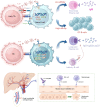The effects of interleukin-21 in the biology of transplant rejection
- PMID: 40376002
- PMCID: PMC12078210
- DOI: 10.3389/fimmu.2025.1571828
The effects of interleukin-21 in the biology of transplant rejection
Abstract
Interleukin-21 (IL-21) is a cytokine that plays a crucial role in regulating immune responses, affecting various immune cell types, including T cells, B cells, natural killer (NK) cells, and dendritic cells. IL-21 is primarily produced by CD4+ T cells, particularly follicular helper T (Tfh) cells and Th17 cells, and has been shown to be extensively involved in regulating both innate and adaptive immunity. IL-21 is particularly significant in the differentiation, proliferation, and effector functions of T cells and B cells. In the context of organ transplantation, IL-21 contributes to the promotion of acute transplant rejection and the development of chronic rejection, which is primarily antibody-mediated. This review summarizes relevant studies on IL-21 and discusses its multifaceted roles in transplant immune rejection, providing insights into therapeutic strategies for either inhibiting graft rejection or promoting tolerance. It also explores the feasibility of blocking the IL-21 signaling pathway within current immunosuppressive regimens, aiming to provide further clinical references.
Keywords: B lymphocyte; T lymphocyte; antibody-mediated rejection (AMR); interleukin-21 (IL-21); transplant rejection.
Copyright © 2025 Zeng, Pan, Xia and He.
Conflict of interest statement
The authors declare that the research was conducted in the absence of any commercial or financial relationships that could be construed as a potential conflict of interest.
Figures




Similar articles
-
IL-21R-Targeted Nano-immunosuppressant Prevents Acute Rejection in Allogeneic Transplantation by Blocking Maturation of T Follicular Helper Cells.Acta Biomater. 2025 Jun 1;199:346-360. doi: 10.1016/j.actbio.2025.05.012. Epub 2025 May 6. Acta Biomater. 2025. PMID: 40339970
-
T Follicular Helper Cells in Transplantation.Transplantation. 2016 Aug;100(8):1650-5. doi: 10.1097/TP.0000000000001217. Transplantation. 2016. PMID: 27362303 Review.
-
Interleukin-6, A Cytokine Critical to Mediation of Inflammation, Autoimmunity and Allograft Rejection: Therapeutic Implications of IL-6 Receptor Blockade.Transplantation. 2017 Jan;101(1):32-44. doi: 10.1097/TP.0000000000001452. Transplantation. 2017. PMID: 27547870 Review.
-
Elevated number of IL-21+ TFH and CD86+CD38+ B cells in blood of renal transplant recipients with AMR under conventional immuno-suppression.Int J Immunopathol Pharmacol. 2022 Jan-Dec;36:20587384211048027. doi: 10.1177/20587384211048027. Int J Immunopathol Pharmacol. 2022. PMID: 35012395 Free PMC article. Clinical Trial.
-
The innate natural killer cells in transplant rejection and tolerance induction.Curr Opin Organ Transplant. 2008 Aug;13(4):339-43. doi: 10.1097/MOT.0b013e3283061115. Curr Opin Organ Transplant. 2008. PMID: 18685327 Review.
References
Publication types
MeSH terms
Substances
LinkOut - more resources
Full Text Sources
Medical
Research Materials

